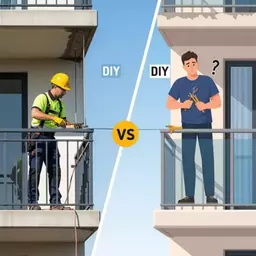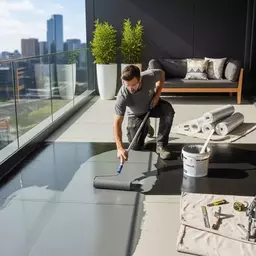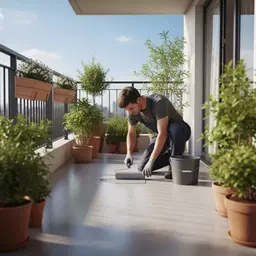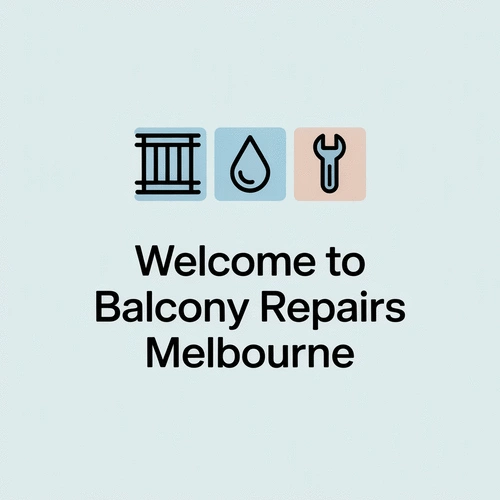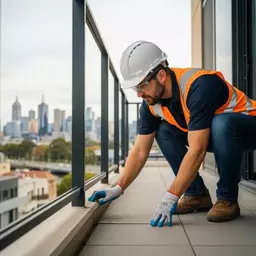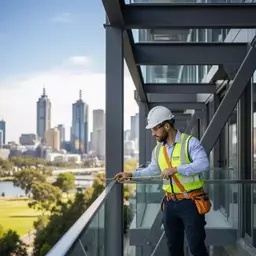Balcony waterproofing is not just a maintenance task; it's a critical investment in the safety and durability of your outdoor space. With frequent rains in Melbourne, understanding the best waterproofing methods can prevent costly repairs down the line. Ready to dive into essential insights?
What You Will Learn
- Balcony waterproofing protects against structural damage, mold, and health risks from moisture.
- Common waterproofing methods include liquid membranes, sheet membranes, coatings, and self-adhesive membranes.
- Eco-friendly waterproofing options, like low-VOC coatings and biodegradable membranes, contribute to a sustainable environment while keeping your balcony safe.
- While DIY waterproofing can save money, it also comes with risks like time consumption and quality control challenges.
Balcony Waterproofing Comparison: DIY vs. Professional Approach
This visual compares the benefits and challenges of DIY balcony waterproofing against the professional approach, highlighting key considerations for homeowners. To delve deeper into protecting your outdoor space, explore various waterproofing solutions for Melbourne balconies.
DIY Balcony Waterproofing
Benefits
- ✓ Cost Efficiency
- ✓ Personal Satisfaction
- ✓ Flexible Scheduling
Challenges
- ✖ Time-Consuming
- ✖ Quality Control Risks
- ✖ Safety Hazards
Professional Waterproofing
Benefits
- ✓ Expert Quality & Durability
- ✓ Time-Saving
- ✓ Guarantees & Warranties
Considerations
- ⚠ Higher Initial Cost
- ⚠ Scheduling Dependencies
- ⚠ Less Personal Involvement
Understanding Balcony Waterproofing: Key Concepts and Importance
When it comes to maintaining your balcony, waterproofing is a crucial aspect that shouldn't be overlooked. Imagine enjoying a sunny afternoon on your balcony only to find water leaks damaging the structure beneath you. That's why understanding balcony waterproofing is essential—it's not just about aesthetics; it's about safety and longevity!

Essentially, balcony waterproofing involves applying materials that prevent water from penetrating the surface. This keeps your balcony dry and protects your property from structural damage, mold, and other costly issues. In Melbourne, where rain can be frequent, the importance of a well-executed waterproofing system cannot be stressed enough.
What is Balcony Waterproofing and Why is it Essential?
Balcony waterproofing refers to the process of making your balcony impervious to water. This is vital because moisture can lead to a myriad of problems, including structural damage and health risks from mold growth. By investing in effective waterproofing, you are enhancing the safety and durability of your outdoor space.
- Prevents water damage: Regular exposure to water can weaken the structure.
- Improves safety: A well-maintained balcony is safe for you and your guests.
- Enhances aesthetics: Keeps your balcony looking great with minimal upkeep.
At Balcony Repairs Melbourne, we understand that each balcony is unique, which is why we tailor our waterproofing solutions to meet the specific needs of your property. Whether you have a small apartment balcony or a large commercial space, we are here to guide you through the process, ensuring your balcony meets balcony waterproofing standards and practices.
Common Waterproofing Methods for Balconies: An Overview
There are several methods available for waterproofing balconies, each with its own set of advantages. Understanding these methods will help you make an informed decision about which one is right for your balcony. Here are some of the most common methods:
- Liquid membranes
- Sheet membranes
- Coatings
- Self-adhesive membranes
Each method has its pros and cons. For instance, liquid membranes offer seamless coverage, while sheet membranes may provide better puncture resistance. It’s essential to evaluate your specific requirements and the conditions of your balcony before deciding on a waterproofing method.
Exploring Different Waterproofing Systems: Membranes, Paints, and Coatings
As we delve deeper into waterproofing systems, it's important to understand the differences between membranes, paints, and coatings. Each option provides unique benefits:
- Membranes: These are typically rubber or plastic sheets that create a barrier against moisture.
- Paints: Specialized waterproof paints can be applied directly to the surface, providing a protective layer.
- Coatings: These are thicker than paint and can form a durable surface that resists water.
Choosing the right system largely depends on your balcony's specific needs, including exposure to weather, foot traffic, and desired aesthetics. My team at Balcony Repairs Melbourne can help you determine the best waterproofing approach tailored to your situation.
Environmental Considerations in Balcony Waterproofing: Choosing Eco-Friendly Options
As an industry expert, I believe that eco-friendly options are becoming increasingly important in balcony waterproofing. Not only do they protect your property, but they also help safeguard our environment. Here are some eco-friendly choices you might consider:
- Low-VOC (Volatile Organic Compounds) coatings
- Biodegradable membranes
- Recyclable materials
By selecting eco-friendly waterproofing materials, you contribute to a healthier planet while ensuring the safety of your balcony. If you're interested in these options, feel free to reach out to me at Balcony Repairs Melbourne for more information!
Engage with Us!
We want to hear from you! Have you ever considered taking on a DIY balcony waterproofing project? What factors influenced your decision? Share your thoughts below:
Evaluating DIY Balcony Waterproofing: Benefits and Challenges
When it comes to balcony waterproofing, many homeowners consider the DIY approach. It’s an attractive option, promising both cost savings and a sense of personal achievement. But before diving in, it’s essential to weigh the benefits against the potential challenges. As someone who has worked in balcony restoration for over a decade, I've seen both the triumphs and trials that come with DIY waterproofing.
Let’s break down the pros and cons, helping you make an informed decision for your balcony.
Pros of DIY Balcony Waterproofing: Cost Savings and Personal Satisfaction
One of the biggest draws of DIY balcony waterproofing is the savings. You can often complete projects for a fraction of the cost of hiring a professional. Additionally, the sense of achievement you feel upon successfully waterproofing your balcony can be incredibly rewarding!
- Cost Efficiency: Save on labor costs and materials by doing it yourself.
- Personal Satisfaction: Completing a project on your own can boost your confidence and pride in your home.
- Flexible Scheduling: Work at your own pace without coordinating with a contractor.
However, while the benefits are enticing, it's crucial to understand the challenges that accompany DIY waterproofing.
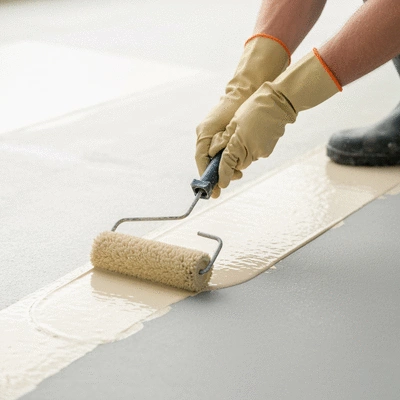
Challenges and Risks of DIY Methods: What You Need to Know
Despite the allure of DIY, it’s important to recognize the potential pitfalls. Many homeowners underestimate the complexity of waterproofing systems and the skills required to execute them correctly.
- Time-Consuming: DIY projects can take longer than expected, especially if you encounter unforeseen issues.
- Quality Control: Without experience, it’s easy to make mistakes that lead to future problems.
- Safety Risks: Working with materials and tools can pose safety hazards if not handled properly.
These challenges are critical to consider, as they can result in additional costs and repairs down the line.
Essential Waterproofing Tools and Kits for DIY Projects
If you decide to tackle your balcony waterproofing project yourself, having the right tools and materials is crucial. Here’s a handy list of essentials to get you started:
- Waterproofing Membrane: A key component for effective moisture protection.
- Paint Roller and Brush: For applying sealants and coatings evenly.
- Caulk Gun: Useful for sealing joints and cracks.
- Safety Gear: Gloves, goggles, and a mask to protect against harmful chemicals.
Equipping yourself with these tools can enhance your chances of a successful DIY project. Just remember, if you ever feel overwhelmed, don’t hesitate to reach out for professional help! You might also find valuable tips on how to clean and waterproof your balcony to ensure longevity.
Common DIY Waterproofing Techniques: Liquid, Paint, and Sealants
There are a variety of methods you can use for DIY balcony waterproofing. Here’s a brief overview of some common techniques:
- Liquid Membranes: Applied as a liquid that cures to form a seamless, waterproof barrier.
- Waterproofing Paint: A durable paint that provides a moisture-resistant layer.
- Sealants: Often used to fill gaps and cracks, preventing water from seeping through.
Choosing the right method depends on your balcony's specific needs and your comfort level with each technique. So, take your time to research and plan accordingly!
Frequently Asked Questions About Balcony Waterproofing
- Q1: Why is balcony waterproofing essential?
- A1: Balcony waterproofing is crucial to prevent structural damage, mold growth, and other costly issues caused by moisture penetration. It enhances the safety and longevity of your outdoor space.
- Q2: What are the common methods for balcony waterproofing?
- A2: Common methods include liquid membranes, sheet membranes, specialized coatings, and self-adhesive membranes. Each method has specific advantages depending on the balcony's requirements.
- Q3: Are there eco-friendly options for waterproofing?
- A3: Yes, eco-friendly options such as low-VOC (Volatile Organic Compounds) coatings, biodegradable membranes, and recyclable materials are available to protect your property and the environment.
- Q4: What are the main benefits of DIY balcony waterproofing?
- A4: Benefits include cost efficiency by saving on labor, personal satisfaction from completing the project yourself, and flexible scheduling.
- Q5: What are the risks associated with DIY balcony waterproofing?
- A5: Risks include projects being more time-consuming than expected, challenges with quality control leading to potential mistakes, and safety hazards if materials and tools are not handled properly.
Recap of Key Points
Here is a quick recap of the important points discussed in the article:
- Importance of Waterproofing: Prevents water damage, improves safety, and enhances the aesthetics of your balcony.
- Common Waterproofing Methods: Liquid membranes, sheet membranes, coatings, and self-adhesive membranes each have unique benefits.
- Eco-Friendly Options: Consider low-VOC coatings, biodegradable membranes, and recyclable materials for environmentally responsible choices.
- DIY Waterproofing: Weigh the benefits of cost savings and personal satisfaction against potential challenges like time consumption and quality control.
- Essential Tools: Equip yourself with a waterproofing membrane, paint roller, caulk gun, and safety gear for successful DIY projects.


